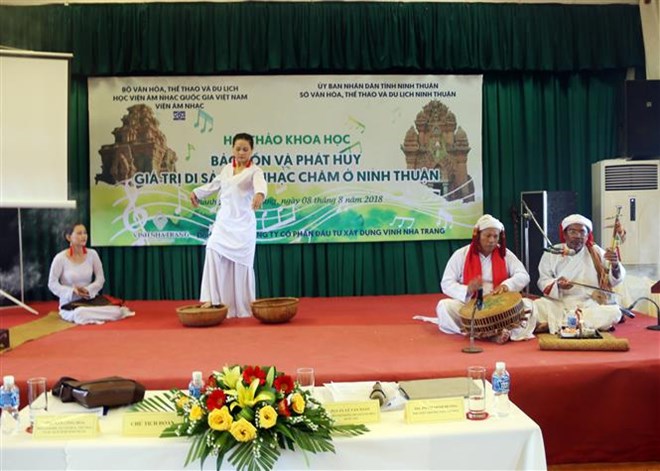
A workshop was held in the central province of Ninh Thuan on August 8, offering a venue for cultural managers, researchers, and artists to seek ways to preserve and promote musical heritage values of the Cham ethnic minority group.

Cham artists perform at the workshop (Source: VNA)
Participants
agreed that Cham musical heritage is facing the risk of fading away, as Cham
artists are getting older or pass away, while the young generation is not
passionate with taking over their successors’ roles.
Nong Quoc Thanh, deputy head of the Cultural Heritage
Department under the Ministry of Culture, Sports and Tourism, said that a lot
of workshops on Cham culture have been held, but there has been no in-depth
discussion about the unique values of the Cham musical heritage as well as
specific measures to preserve the heritage.
At this workshop, researchers stressed the need to step up
the collection, research and identification of the heritage, put Cham music in
schools’ curricula, intensify dissemination on the musical heritage, and create
favourable conditions for old artists to pass over their knowledge to young
people.
Musician Amu Nhan said that it is necessary to make Cham
music part of the popular music scene serving the society’s demand for
entertainment instead of serving only the Cham ethnic community.
The Cham community owns a rich and diverse intangible culture
with 72 ritual and festive activities, including music and dance. Many of them
remain original at present.
Source: VNA
Preserving and promoting the cultural values of the Muong ethnic group has become an urgent task in the current context, as many traditional values face the risk of fading away. This effort requires not only protecting the cultural identity but also eliminating outdated customs and developing a modern cultural lifestyle, contributing to sustainable values for the Muong community in Hoa Binh province.
The Muong ethnic culture, deeply rooted in Vietnam’s mountainous north, continues to be preserved and revitalised by dedicated individuals and communities determined to safeguard their ancestral identity.
The Muong group is one of the largest ethnic minorities in Vietnam, primarily found in Hoa Binh province. The Muong people in Hoa Binh boast a rich and diverse cultural treasure that reflects the unique identity of this ethnic group. Accounting for over 63% of the province's population, they have created and preserved numerous distinctive cultural values, contributing to their unique identity. Their cultural heritage is an invaluable asset, at the heart of their national identity, and represents a vibrant spiritual life that must be preserved and promoted in today’s modern world.
For generations, the ethnic communities of Hoa Binh province, particularly the Muong people, have preserved vibrant festivals deeply intertwined with the region’s geography, nature, and social traditions. These celebrations enrich Hoa Binh’s spiritual life and cultural identity, reflecting both folk beliefs and the intermingling of ethnic customs. Many of these festivals have endured the test of time, passed down through generations and continuing to thrive today. Among them, the Khai Ha (Going Down to the Field) festival stands out as one of the most significant events of the Muong ethnic group.
Muong calendar, known as sach doi, is an ancient folk knowledge system developed through observations of the movement of the pleiades star. This unique calendar consists of 12 bamboo sticks, each representing a lunar month. Specific days within each month are marked with distinct symbols, guiding locals in determining auspicious and inauspicious days for important activities.
Authorities and residents of Chieng Chau commune, Mai Chau district, are making efforts to preserve and promote the historical value of a centuries-old gold apple tree (scientifically known as diospyros decandra lour), which has been recognised as a national heritage tree.



